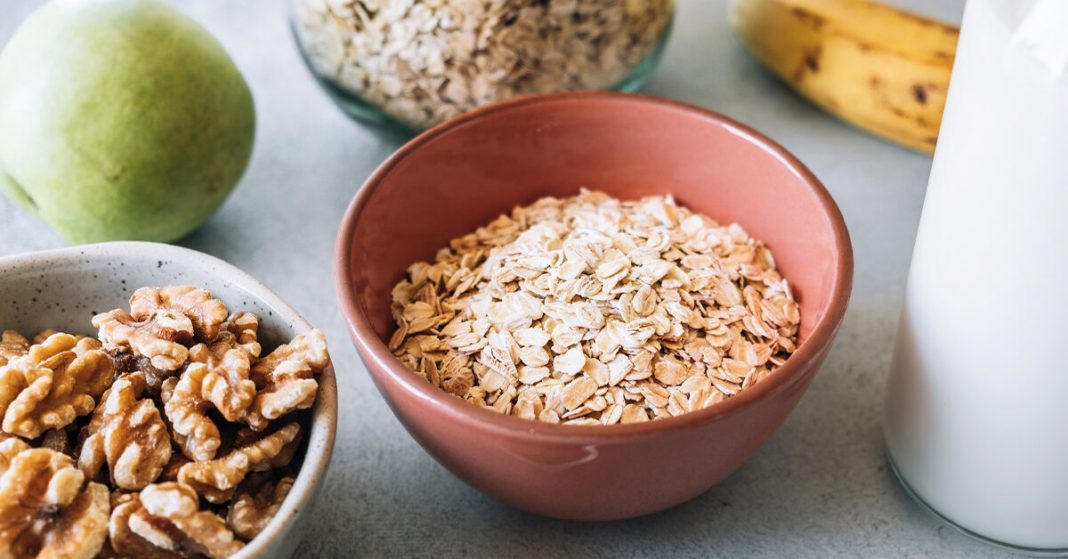Oatmeal is one of the most nutritious and versatile whole grains on the market.
Loaded with fiber and essential vitamins and minerals, oatmeal is a mainstay in household pantries around the world (1).
Whether you fancy using it as a hot breakfast cereal, base for savory and comforting porridge, or want to add texture and fiber to baked goods, there’s no denying that keeping oatmeal on hand is a good idea.
However, if you haven’t used your oatmeal for anything more than a cupboard accessory in a while, you may wonder when it’s time to throw it out.
This article reviews the shelf life of oatmeal and how to know when your stash is ready for a refresh.
Oatmeal has a fairly long lifespan compared with many other foods.
Yet, its precise shelf life can vary dramatically depending on how it was processed, whether it has been cooked, whether any perishable ingredients have been added to it, and the storing method.
Similarly to dried rice or pasta, commercially processed and uncooked rolled, quick, or steel cut oats will typically last at least 12 months — and up to 2 years if the package remains unopened or the oats are stored in an air-tight container (2).
Commercially processed oats usually undergo a steaming process, which contributes to their long shelf life (1).
Unstabilized oats are oats that have not been steamed during processing, and therefore, have a reduced shelf life of about 3–4 months.
Oatmeal that contains other kinds of ingredients like dry milk or fruit can last anywhere from 4 months to 1 year, depending on the type of added ingredients and how it’s stored (3).
If you’re unsure, check the package label for a “best by” or “use by” date.
Similarly to soups and stews, previously cooked or prepared oatmeal shouldn’t be kept longer than about 3–4 days before you toss it. However, if you freeze it, it can be kept safely for up to 3 months (2, 4).
Summary
The shelf life of oatmeal can range from just a few days to up to 2 years depending on how it’s processed, stored, and prepared.
When stored properly, uncooked oatmeal isn’t considered a potentially hazardous food. This means it’s unlikely to spoil in such a way that’ll make you sick if you eat it once it’s past its prime.
That said, the quality of the oats will decline over time, and they may become stale, change color, or develop flavors that aren’t particularly palatable.
If dry oats are exposed to moisture while stored, they’ll be more susceptible to mold growth. If you see any type of mold growing on your oats — whether cooked or dry — do not eat them.
If you’re unsure whether your oats are still good, start by inspecting the color, texture, and scent. If you notice any dark spots, strange odors, or clumping, it’s probably best to throw them out or add them to the compost bin.
Summary
Check your oatmeal for mold or changes in scent, color, or texture to evaluate whether it’s safe to consume.
The trick to maximizing the shelf life of your oatmeal is the storage method.
For uncooked oats, you’ll want to make sure they stay as dry as possible. Minimizing exposure to light and oxygen can help, too.
Store them in a cool, dry place, such as a pantry or cupboard. After their original packaging has been opened, transfer them to a water- and air-tight container, such as a glass, stainless steel, or ceramic jar, to help keep them fresh.
When storing cooked oatmeal, opt for a container with a tight seal, and keep it refrigerated until you’re ready to eat. If you’re freezing it, make sure you store it in a container that’s air-tight to prevent freezer burn.
Summary
To maximize oatmeal’s shelf life, keep it in a cool, dry place with minimal exposure to moisture, air, and light.
Oatmeal is a nutritious pantry staple in households all over the world.
When kept dry, commercially processed oatmeal can last up to 1–2 years. However, the exact shelf life will vary depending on how it was processed, how you store it, whether it has been cooked, and whether any perishable ingredients have been added to it.
If you notice any mold or changes in the color or scent of the oatmeal, it’s best to throw it out.
You can maximize the shelf life of any type of oatmeal by keeping it away from excess moisture and oxygen exposure. Previously cooked oatmeal should always be stored in the refrigerator or freezer until you’re ready to eat it.
